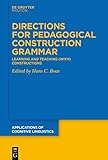Directions for Pedagogical Construction Grammar : Learning and Teaching (with) Constructions / ed. by Hans C. Boas.
Material type: TextSeries: Applications of Cognitive Linguistics [ACL] ; 49Publisher: Berlin ; Boston : De Gruyter Mouton, [2022]Copyright date: ©2022Description: 1 online resource (X, 365 p.)Content type:
TextSeries: Applications of Cognitive Linguistics [ACL] ; 49Publisher: Berlin ; Boston : De Gruyter Mouton, [2022]Copyright date: ©2022Description: 1 online resource (X, 365 p.)Content type: - 9783110746648
- 9783110746778
- 9783110746723
- 415.01836 23
- P163.5 .D574 2022
- online - DeGruyter
- Issued also in print.
| Item type | Current library | Call number | URL | Status | Notes | Barcode | |
|---|---|---|---|---|---|---|---|
 eBook
eBook
|
Biblioteca "Angelicum" Pont. Univ. S.Tommaso d'Aquino Nuvola online | online - DeGruyter (Browse shelf(Opens below)) | Online access | Not for loan (Accesso limitato) | Accesso per gli utenti autorizzati / Access for authorized users | (dgr)9783110746723 |
Frontmatter -- Preface -- Contents -- I Introduction -- From Construction Grammar(s) to Pedagogical Construction Grammar -- II Data and methodology in Pedagogical Construction Grammar -- On, or against?, (just) frequency -- Constructing learner speech: On the use of spoken data in Applied Construction Grammar -- L2-words that go together – more on collocation and learner language -- III Learning and teaching constructions -- Construction-based teaching of German verbless directives to Italian-speaking learners -- Securing strategic input for L2 learners: Constructions with Russian motion verbs -- Pedagogic applications of the English Constructicon -- Learned attention beyond typological bootstrapping: Constructional repertoires and constructional complexity in the spatial language domain -- IV Frame-based teaching and learning -- Teaching second year German using frames and constructions -- Frame-based metonymy in teaching L2 vocabulary -- Towards a FrameNet for linguistic terminology: Theoretical foundations, lexicographic practice, didactic potential -- Author Index -- Subject Index
restricted access online access with authorization star
http://purl.org/coar/access_right/c_16ec
How can insights from Construction Grammar (CxG) be applied to foreign language learning (FLL) and foreign language teaching (FLT)? This volume explores several aspects of Pedagogical Construction Grammar, with a specific look at issues relevant to second language acquisition, FLL, and FLT. The contributions in this volume discuss a wide range of constructions, as well as different resources, methodologies, and data used to learn constructions in the language classroom. More specifically, they seek to provide answers to the following questions: What do new constructional approaches to teaching and learning foreign language look like that take the insights of CxG seriously? What should electronic resources using constructions and semantic frames for foreign language instruction look like? How should constructions (pairings of form with meaning/function) in the foreign language classroom be introduced? What role does frequency play in learning constructions in the language classroom? What types of strategies does CxG offer to facilitate the acquisition of a second language? This volume is relevant for anyone interested in second language acquisition, foreign language pedagogy, Construction Grammar, and Cognitive Linguistics. Endorsements: If first language learning flows forth from language use, teaching language should be based on relevant usage-patterns, modified in accordance with the advanced cognitive and linguistic knowledge of older learners. The current volume shows how insights from first and second language learning and usage-based Construction Grammar can be turned into evidence-based teaching strategies.Heike Behrens, University of Basel Usage-based Construction Grammar has changed our view of language learning, but it is only recently that researchers have begun to apply the insights of the constructionist approach to language pedagogy. This volume brings together a collection of articles in which experts of Construction Grammar and Usage-based Linguistics make concrete proposals for teaching constructions by using corpora and other resources. A must read for everybody interested in grammar teaching.Holger Diessel, University of Jena With Directions for Pedagogical Construction Grammar, Boas has produced an impressive and much-needed volume which excels at illustrating the immense potential of constructionist approaches to improve language pedagogy. The contributions to this volume, all authored by leading cognitive and corpus linguists, convincingly describe what a successful future of language teaching could look like—one that is founded in usage-based linguistics and takes language patterns seriously. I consider this volume essential reading for any applied linguist.Ute Römer, Georgia State University
Issued also in print.
Mode of access: Internet via World Wide Web.
In English.
Description based on online resource; title from PDF title page (publisher's Web site, viewed 25. Jun 2024)


